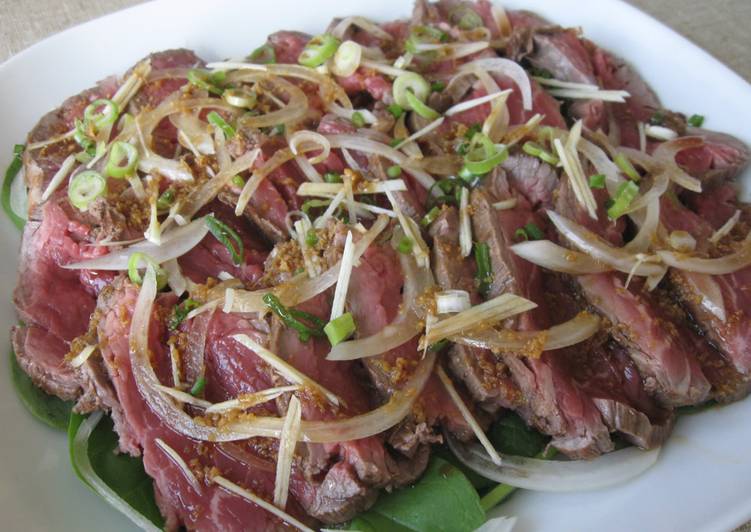
Hey everyone, it is Jim, welcome to our recipe page. Today, I’m gonna show you how to prepare a special dish, beef tataki. One of my favorites. For mine, I will make it a bit unique. This is gonna smell and look delicious.
Tataki is a typical Japanese preparation in which beef or fish is seared on the outside, left very rare inside, thinly sliced and served with a citrusy soy sauce. In this version, a springy salad of crisp radishes and carrot matchsticks combined with sliced onion provides textural contrast to the flavorful steak. Beef tataki refers to a Japanese method of preparing fillet beef, where the meat is lightly seared, marinated, sliced thinly similar to sashimi, and served with a citrus-soy dipping sauce. This easy and delicious recipe provides step-by-step instructions for making the perfect beef tataki.
Beef Tataki is one of the most well liked of recent trending meals on earth. It’s simple, it is fast, it tastes delicious. It’s appreciated by millions every day. Beef Tataki is something which I’ve loved my entire life. They’re nice and they look wonderful.
To begin with this recipe, we must prepare a few components. You can have beef tataki using 11 ingredients and 7 steps. Here is how you cook that.
The ingredients needed to make Beef Tataki:
- Get 600-700 g Fresh Beef Fillet
- Prepare Salt
- Make ready Pepper
- Get 1 small piece Ginger *grated
- Prepare 1 clove Garlic *grated
- Take 1/2 tablespoon Oil
- Get Onion
- Get Baby Spinach OR other leafy vegetables
- Take Spring Onion
- Make ready 1-2 cloves Garlic *sliced into thin strips
- Prepare Your Favourite Sauce such as 'Ponzu' + Sesame Oil, Wasabi, Garlic, Ginger or your favourite flavour
It also happens to be pretty pricey. This variation on classic beef carpaccio cooks the meat following a Japanese technique, which calls for quickly searing it over high heat so that the inside remains rare. Here, beef tenderloin is roasted at a high oven temperature, allowed to cool and then flavored with a ginger-infused marinade. The term tataki refers to beef or fish that is seared, then chilled, marinated and thinly sliced.
Instructions to make Beef Tataki:
- Prepare the sauce. The sauce for 'Beef Tataki' is Ponzu base. Ponzu itself is quite nice, but you can add Sesame Oil, Wasabi, Garlic or Ginger for more flavours. Create your own Tataki sauce. See http://www.hirokoliston.com/dipping-sauce/
- Sprinkle some Salt, Pepper, grated Ginger and grate Garlic onto the Beef Fillet, and massage them well.
- Heat Oil in a frying pan over medium-high heat and cook beef piece on all sides turning occasionally, until all sides are well browned.
- Dip the Beef in ice water for a few seconds, dry with paper towel and wrap it with plastic wrap. Place it in freezer to half freeze. This will make it easier to slice thinly.
- While freezing the Beef, slice Onion very thinly. Chop up Spring Onion and slice Garlic into thin strips.
- Slice the half frozen beef thinly.
- Arrange Baby Spinach and the thinly sliced Onion onto a large plate, then place beef slices on top. Sprinkle chopped Spring Onion, Garlic strips and the sauce. You can serve the sauce as a dipping sauce.
Here, beef tenderloin is roasted at a high oven temperature, allowed to cool and then flavored with a ginger-infused marinade. The term tataki refers to beef or fish that is seared, then chilled, marinated and thinly sliced. This ginger beef version is served with traditional tataki accompaniments—grated daikon (white. A popular Japanese dish, tataki refers to beef or fish that is quickly seared over high heat, leaving the center very rare. It's thinly sliced and served with a citrus- and ginger-infused vinegar soy sauce.
So that is going to wrap it up with this special food beef tataki recipe. Thanks so much for reading. I am confident that you will make this at home. There is gonna be interesting food in home recipes coming up. Don’t forget to bookmark this page on your browser, and share it to your loved ones, friends and colleague. Thank you for reading. Go on get cooking!

